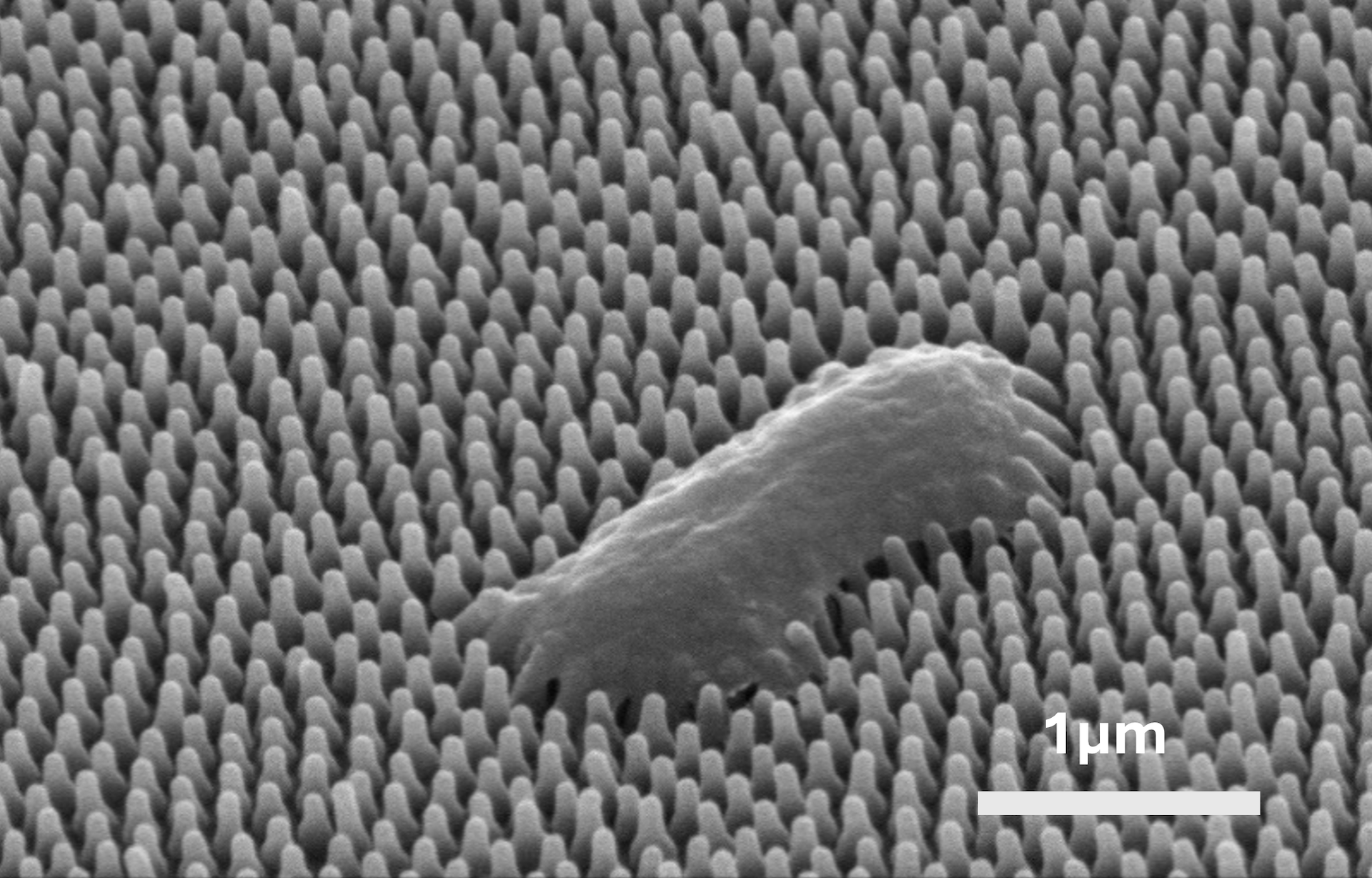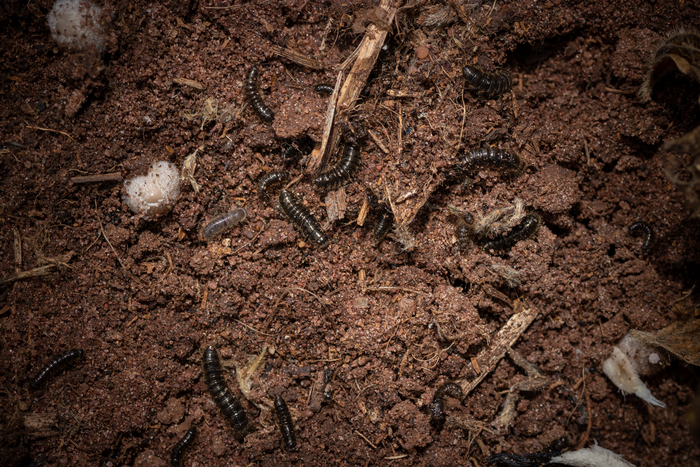Inspired by cicada wings, researchers at the University of Illinois Urbana-Champaign’s Beckman Institute for Advanced Science and Technology study the insects’ antimicrobial properties to develop new antibacterial surfaces.

news, journals and articles from all over the world.

Inspired by cicada wings, researchers at the University of Illinois Urbana-Champaign’s Beckman Institute for Advanced Science and Technology study the insects’ antimicrobial properties to develop new antibacterial surfaces.
Virginia Tech researchers have found a new way to identify genetic targets useful for control of mosquito populations, potentially offering an alternative to insecticides.

You’re settling down in your patio chair, ready to enjoy a book, a pitcher of lemonade, and the sun-warmed breeze, when a mosquito settles down on your arm. And another lands on your leg, while another buzzes right by your ear. Virginia Tech entomologist Eric Day says that when it comes to controlling mosquitoes, there aren’t easy short cuts.

It’s visually striking. When fully grown, open wings display showy hind wings with bright red near the abdomen, black spots, and black-and-white bars. But the spotted lanternfly, an invasive insect that came to the United States from its native habitat of Southeast Asia in 2014, is destructive. Despite its name, though, the spotted lanternfly is not a fly.

For many people, fireflies lighting up backyards is a sign of summertime. The thrill of catching them in a jar and releasing them back into the wild is a childhood pastime. But if you have noticed a decline in fireflies over the years, you’re not alone. Virginia Tech entomologist Eric Day explains why climate and urban development are playing a big role in the decreasing numbers.
For the first time in more than 200 years, two broods of cicadas Brood XIX, known as the Great Southern Brood, and Brood XIII, known as the Northern Illinois Brood will emerge from the ground simultaneously. Hannah Burrack, professor and chair of the Department of Entomology at Michigan State University, answers questions about this rare occurrence.

With summerlike temperatures on their way out and cooler temperatures moving in, homeowners may start to see more uninvited guests inside, particularly the brown marmorated stink bug. Virginia Tech experts say not only are these bugs a nuisance, they also pose an economic threat to farmers. But, there are some positives to having them around as well.
Iowa State researchers are developing mathematical models to simulate soybean aphid population dynamics over a growing season with a wide array of stressors, including droughts and floods. The project received a USDA grant earlier this year and is in collaboration with entomologists at Ohio State University.

Hammerhead worms are once again making their way to backyards across the United States. They were most recently spotted in Washington, D.C and Virginia but have been around for some time.

Virginia’s most infamous hitchhiker is on the move again: the spotted lanternfly. These insects colonize quickly, disrupt native ecosystems, and potentially cause problems to human health and agriculture. The College of Agriculture and Life Sciences and the Department of Entomology at Virginia Tech and the Virginia Department of Agriculture and Consumer Services have partnered to empower the citizens of the commonwealth to take action themselves on these most unwelcome visitors.
Without intervention, the colorful but devastating Japanese beetle could make its way across the evergreen state within two decades, according to a study of their potential dispersion.
Put yourself in the exoskeleton of a bumblebee for a moment: your world would be a riot of colors and scents, both essential to guide your search for pollen and nectar.
It is hatching season for the spotted lanternfly, an invasive insect from Asia that a West Virginia University expert describes as a “serious economic threat” to agricultural industries. First detected in Pennsylvania in 2014, the spotted lanternfly has since been found…
Among the approximately 2,000 known species of termites, some are ecosystem engineers. The mounds built by some genera, for example Amitermes, Macrotermes, Nasutitermes, and Odontotermes, reach up to eight meters high, making them some of the world’s largest biological structures.
Keeping queen bees chilled in indoor refrigeration units can make the practice of “queen banking” — storing excess queens in the spring to supplement hives in the fall — more stable and less labor-intensive, a Washington State University study found.
Zoologist Professor Rainer Willmann, former Director of the Zoological Museum at the University of Göttingen, has described and classified previously unknown species of scorpionflies from Nepal.
Tick bites transmit Lyme disease. But even knowing where these ticks live doesn’t necessarily mean you can predict the disease in humans.

Beetles of the genus Lagria need a little help from their bacterial friends throughout their immature life stages. But keeping them in the same spot throughout life isn’t feasible.
Several species of California bumble bees have gone missing in the first statewide census of the fuzzy pollinators in 40 years. If they can be found, a recent court ruling could help save them.
Scientists have been warning for quite some time that monarch butterflies were headed for extinction. But to misquote Mark Twain, rumors of their demise were greatly exaggerated. A new study found that growth in the summer population has compensated for losses during the winter.
Many curious animals can be found on the Indonesian Island of Sulawesi – such as the deer-hog and the midget buffalo.
Herbivorous insects are a threat to gardeners’ hard work, and are increasingly resistant to pesticides. Today, scientists report they have bottled the “smell of fear” from predators to repel destructive insects without the need for harsh substances. They will present their results at ACS Fall 2021.
A new UC Riverside study shows that a type of insecticide made for commercial plant nurseries is harmful to a typical bee even when applied well below the label rate.
Butterflies and moths (order Lepidoptera) are one of the most diverse animal groups. To date, scientists have found as many as 5,000 species from the Alps alone. Having been a place of intensive research interest for 250 years, it is…
New testing technique could quickly find new ways to suppress ovulation with few side effects.
Evolution is often portrayed as a tree, with new species branching off from existing lineages, never again to meet. The truth however is often much messier. In the case of adaptive radiation, in which species diversify rapidly to fill different…
North Carolina State University researchers have created insecticide-free, mosquito-resistant clothing using textile materials they confirmed to be bite-proof in experiments with live mosquitoes. They developed the materials using a computational model of their own design, which describes the biting behavior…
Butterflies and moths have beautiful wings: the bright flare of an orange monarch, the vivid stripes of a swallowtail, the luminous green of a Luna moth. But some butterflies flutter on even more dramatic wings: parts of their wing, or…
UOC researchers develop a method that can be contribute to investigate and control disease-transmitting tiger mosquitoes
ITHACA, N.Y. – Placing rodent traps and bait stations based on rat and mouse behavior could protect the food supply more effectively than the current standard of placing them set distances apart, according to new research from Cornell University. Rodents…
New modelling study reinforces the importance of reducing emissions and increasing surveillance in potential ‘hotspot’ areas
Max Planck researchers decipher the chemical language underlying mating in 99 species of the genus Drosophila
Flies have discriminating taste. Like a gourmet perusing a menu, they spend much of their time seeking sweet nutritious calories and avoiding bitter, potentially toxic food. But what happens in their brains when they make these food choices? Yale researchers…
An international research team led by a researcher from the University of Tsukuba proposes that catering to different visitors has influenced flower evolution
For patients who have inflammatory bowel syndrome (IBS), the condition is literally a pain in the gut. Chronic — or long-term — abdominal pain is common, and there are currently no effective treatment options for this debilitating symptom. In a…
The unique mechanical and optical properties found in the exoskeleton of a humble Asian beetle has the potential to offer a fascinating new insight into how to develop new, effective bio-inspired technologies. Pioneering new research by a team of international…
The original Star Trek television series took place in a future when space is the final frontier, but humanity hasn’t reached that point quite yet. As researchers like Michigan State University entomologists Sarah Smith and Anthony Cognato are reminding us, there’s still plenty to discover right here on Earth.
Working in Central and South America, the duo discovered more than three dozen species of ambrosia beetles — beetles that eat ambrosia fungus — previously unknown to science. Smith and Cognato described these new species on June 16 in the journal ZooKeys.
Researchers show for first time that commonly used herbicides can persist within wild forest plants for years, reducing fertility long-term and potentially also impacting pollinators
People–who get lost easily in the extraordinary darkness of a tropical forest–have much to learn from a bee that can find its way home in conditions 10 times dimmer than starlight. Researchers at the Smithsonian Tropical Research Institute’s (STRI) research…
Evolutionary biologists at the University of Bonn scan 219 species in different particle accelerators
The environmental risks of pesticides need to be revised
Researchers at Osaka University use innovative imaging techniques to dynamically demonstrate that symmetric, collective alignment of cell nuclei influences left-right asymmetric development in the midgut of the fruit fly embryo
June 15, 2021 – Canadian researchers have discovered that a bee thought to be one of the rarest in the world, as the only representative of its genus, is no more than an unusual specimen of a widespread species. Scientists…
Researchers at the University of São Paulo discover that the fungus Fusarium verticillioides uses volatile compounds to manipulate insects and plants, promoting its own dissemination
Mosquitoes can adjust to rapid changes in temperature, indicating that mosquitoes normally dormant during winter may become active year-round
WOODS HOLE, Mass. — Many animals have evolved camouflage tactics for self-defense, but some butterflies and moths have taken it even further: They’ve developed transparent wings, making them almost invisible to predators. A team led by Marine Biological Laboratory (MBL)…
Climate change exerts great pressure for change on species and biodiversity. A recent study conducted by the University of Helsinki and the Finnish Environment Institute indicates that the few moth and butterfly species (Lepidoptera) capable of adjusting to a changing…
Watching honeybees buzz among flowers, it’s easy to see how the expression “busy as a bee” arose. One of many movements a bee’s body makes is the repetitive curving and straightening of its abdomen. Now, researchers reporting in ACS Applied…
Moth wing structure, composition absorb bat echolocation calls
While captive rearing may cause temporary disorientation, researchers found if Monarchs are given time in the wild to calibrate their internal compasses they can fly in the proper direction